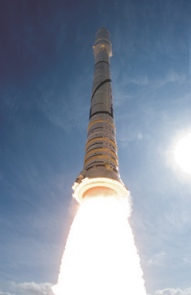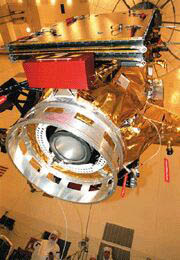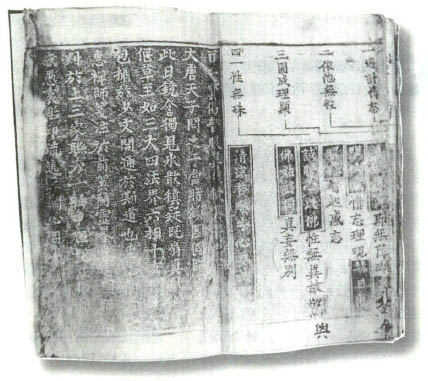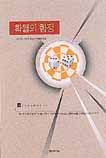There are a lot of reasons astronauts haven't moved beyond the low-Earth orbit in nearly 40 years. One of them is that we haven't had the machines to take us anywhere else. In 2004, however, the U.S. committed itself to sending astronauts back to the moon and later to Mars. And for that, you need something new and nifty for them to fly. The answer is the Ares 1, which had its first unmanned flight on Oct. 28 and dazzled even the skeptics.
When NASA engineers gathered to design the next generation of rockets, they thus decided to go back to the future - using time machines. The Saturn V was the brainchild of Wernher von Braun, the
German scientist whose bright genius gave the U.S. its finest line of rockets - and whose dark genius gave Hitler the V2 missile that rained terror on London. Von Braun had, in turn, drawn insights from American rocket pioneer Robert Goddard, and Goddard built on the work of 17th century artillery innovator Kazimierz Siemienowicz.
The Ares 1 is a worthy descendant of them, with lightweight composites, better engines and drastically improved computers giving it more reliability and power. The Ares 1 will launch an Apollo-like spacecraft with four crew members, perhaps by 2015. Alongside it, NASA is developing the Ares V, a 380-ft(116m) behemoth intended to put such heavy equipment as a lunar lander in Earth orbit. astronauts would link up with it and blast away to the moon there.
The new rockets could take astronauts to some thrilling places. The biggest costs and risks associated with visiting other celestial bodies are from landing and taking off again. But suppose you don't land? Under the new thinking, astronauts could barnstorm planets or circle the moon, Mars and Mars' twin moons, deploying probes to do their rock-collecting and experiments for them. They could similarly sample near-Earth objects like asteroids.
There's no way of knowing if those projections are too rosy, but if history teaches us anything, it's that the space program's grimmest chapters - the launch pad fires and shuttle disasters - unfold when policy planners lean too hard on engineers. The finest moments occur when the bureaucrats give the designers a clean sheet of drafting paper and let them dream. There's genius in knowing how to create a truly big invention; and there's wisdom in knowing how to recognize it and use it.
<해석>TIME지가 선정한 2009년 최고의 발명품: NASA의 아레즈 로켓
Check Point
2009년말 시사주간지 타임은 2009년 최고의 발명품 50가지를 선정했다. 수많은 경쟁자를 제치고 1위를 차지한 것은 다름 아닌 NASA에서 새롭게 디자인한 미래형 로켓 아레즈이다.
http://tinyurl.com/6ar75b는 아레즈 로켓에 대한 설명과 여러 자료를 담고 있는 NASA의 홈페이지이다. 시험발사 동영상과 관련 자료가 제공된다.
지난 40년간 우주비행사들을 지구의 저(低)궤도보다 멀리 보낼 수 없었던 데는 여러 가지 이유가 있다. 그중 하나는 인간을 그런 곳으로 보낼 수 있는 기계가 없었기 때문이다. 2004년에 미국은 달보다 더 먼 곳으로, 나중에는 화성으로 우주비행사를 보낼 것이라고 발표했다. 그러기 위해서는 뭔가 새롭고 멋진 비행선이 필요했다. 그 답이 2009년 10월28일 무인 발사에 성공한 아레즈 1호로 회의적이었던 많은 사람들마저 감탄하게 만든 작품이다.
NASA의 엔지니어들이 모여 다음 세대의 로켓을 디자인할 때, 그들은 타임머신을 타고 과거의 시점으로 가보기로 했다. 새턴5호 로켓은 독일의 천재 과학자 베르너 폰 브라운의 작품이다. 폰 브라운은 런던을 공포에 몰아넣은 V2 로켓을 히틀러에게 선물한 바 있다. 폰 브라운은 미국의 로켓 선구자인 로버트 고다드에게서 아이디어를 얻었고, 고다드는 17세기 대포 제작자인 카지미어즈 지미노비치에게서 영향을 받았다.
아레즈 1호는 이들의 자랑스런 후손에 해당한다. 가벼운 합성 재료와 향상된 엔진을 갖추고 있고 성능이 뛰어난 컴퓨터를 사용하기 때문에 더 나은 안정성과 출력을 갖췄다. 아마도 2015년까지 아레즈 1호는 4명의 우주비행사를 태우고 아폴로호와 비슷한 우주선을 발사시킬 것이다. NASA는 이와 함께 116m 크기의 거대한 아레즈 5호도 개발하고 있는데, 이는 달 착륙선처럼 무거운 물체를 지구 궤도에 올려놓을 것이다. 우주비행사들은 지구 궤도에서 착륙선과 도킹돼 달로 발사될 것이다.
새로운 로켓은 우주인을 흥미진진한 곳으로 데려다줄 수 있다. 다른 천체를 방문할 경우 착륙할 때와 다시 발사할 때 가장 큰 비용이 들며 큰 위험요소가 발생한다. 그런데 만약 착륙할 필요가 없다면? 이 새로운 발상이 실현되면 우주인은 행성에 순회방문을 하거나 달, 화성, 화성의 두 위성 주변을 공전할 수 있을 것이다. 그러면서 암석을 채집하고 실험을 수행할 탐사선을 보낼 수 있다. 비슷한 방식으로 지구 근처 소행성에도 접근할 수 있을 것이다.
이러한 예측이 낙관적인지 여부를 증명할 방법은 없다. 하지만 정책 입안자들이 지나치게 엔지니어를 규제할 경우 우주선 발사 화재와 우주왕복선 참사와 같은 참혹한 사건이 발생하게 된다는 것을 지나온 역사를 통해 알 수 있었다. 가장 이상적인 것은 관료들이 디자이너에게 깨끗한 백지를 주고 꿈을 그려가게끔 하는 것이다. 뛰어난 발명품을 제작하기 위해서는 천재성이 필요하고, 그것을 잘 활용하는 데에는 지혜가 필요한 법이다.
기사 원문의 저작권은 타임워너사에 있으며, 본고는 국내 학생들의 영어교육을 위해 재편집된 것임을 알려드립니다.

















